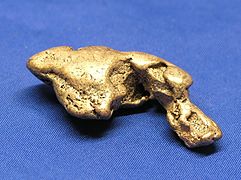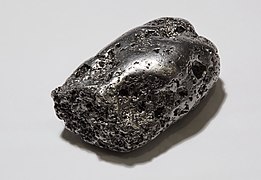Nugget (metallurgy)


A nugget is a lump of gold or platinum that has arisen naturally. Nuggets are found in soaps and are usually the size of a dust or grain. However, there are other metals of which nuggets occur, e.g. B. Copper (very rare). Even naturally occurring solid silver is now colloquially known as “nugget”, although it is less about lumps than about threads (so-called “curly silver”).
With a gold content of 2316 troy ounces (around 72 kg), the largest gold nugget to date was found in Moliagul / Australia in 1869 and baptized with the name Welcome Stranger . Three years later, the German mining entrepreneur Bernhardt Otto Holtermann found the 214 kg Holtermann nugget in New South Wales, which, with a fine gold content of around 57 kg (26.64%), was actually not a nugget, but only a chunk of gold quartz with a very high gold content is. The term nugget is used for very high degrees of purity; Nuggets found in Australia are often 95% or more pure. The heaviest nugget found in Germany weighs 10.2 g. Most large gold nuggets are later melted down. A platinum nugget weighing twelve kilograms was found in the Urals ( Russia ) in 1843. Finds of five and a half kilograms of gold are classified as newsworthy by the media.
Copper nugget, brass-colored
Platinum nugget from the Khabarovsk
Gold nuggets, NHM Vienna
Bismuth nugget from Bolivia
Formation of gold nuggets
Nuggets are created by the erosion of gold-bearing mineral veins . Gold is chemically very resistant, so that the surrounding rock or the quartz , which often occurs together with gold, can be removed through weathering and transport in streams and rivers without the gold disintegrating. Large areas of solid gold from which nuggets could form are very rare, however, as the gold is usually finely distributed in the ore. For this reason, the majority of gold deposits that result from the weathering of gold-bearing ores consist of fine gold particles.
An additional possibility of formation is that gold nuggets come about through bacterial activities in biofilms . Certain bacteria convert dissolved gold that is toxic to them into non-toxic metallic gold, which they excrete. In 2006, a group of Australian researchers led by Frank Reith from the Research Center for Environment and Mineral Exploration in Bentley , Perth , published that they had found biofilms containing the bacterium Ralstonia metallidurans on almost all gold grains in two gold mines . This was the first time that indications could be found that this type of nugget formation is possible.
Nugget finds in Germany
At the beginning of May 2004, Heinz Martin, a pensioner from Katzhütte , accidentally found a sparkling gold nugget weighing 9.64 g in a ford through the creek Katzen in the upper Schwarzatal . The authenticity of the gold and the naturalness of the nugget as well as the probable authenticity of the location were verified by Markus Schade. It is the second heaviest nugget ever found in Germany. It had an estimated collector's value at the time of around 1500 euros. The find triggered a local gold rush, it was the first find in Germany in around 400 years. The heaviest nugget found in Germany (also in the Schwarzatal) weighs 10.2 g. It is incorporated into a jewelery basket from the 16th century and, as a processed nugget, is therefore likely to have a lower collector's value than the unprocessed nugget from 2004.
One way to find nuggets was to set up a mud mill . Today metal detectors play an increasing role.
Individual evidence
- ↑ About Welcome Stranger
- ↑ Gold Nugget Goldankauf Pro24 Munich, accessed August 25, 2016. - About the Holtermann- and other nuggets.
- ↑ http://www.thueringer-allgemeine.de/web/zgt/suche/detail/-/specific/Goldsucher-findet-Fuenf-Kilo-Nugget-431021624 ( page no longer available , search in web archives ) Info: The link was automatically marked as defective. Please check the link according to the instructions and then remove this notice.
- ↑ Regulation of heavy metal homeostasis in Ralstonia metallidurans (forschung-sachsen-anhalt.de)
- ↑ scienceticker.info: Bacteria spin gold ( Memento of the original from September 28, 2007 in the Internet Archive ) Info: The archive link was inserted automatically and has not yet been checked. Please check the original and archive link according to the instructions and then remove this notice. , July 13, 2006, accessed August 25, 2016.
- ↑ Frank Reith, Stephen L. Rogers, DC McPhail, Daryl Webb: Biomineralization of Gold: Biofilms on Bacterioform Gold . In: Science . tape 313 , no. 5784 , July 14, 2006, p. 233-236 , doi : 10.1126 / science.1125878 .
- ↑ Gold search in Thuringia ( Memento of the original from December 19, 2014 in the Internet Archive ) Info: The archive link was automatically inserted and not yet checked. Please check the original and archive link according to the instructions and then remove this notice.
- ↑ nugget finds in Germany
- ↑ Description of the 2004 find in the Schwarzatal and photo of the nugget (gasthof-korn.de) Gold nugget in the Schwarza ( Memento from September 28, 2007 in the Internet Archive )
- ↑ http://www.thueringer-allgemeine.de/web/zgt/suche/detail/-/specific/Goldsucher-findet-Fuenf-Kilo-Nugget-431021624 ( page no longer available , search in web archives ) Info: The link was automatically marked as defective. Please check the link according to the instructions and then remove this notice. - mentioned in the video - no longer available on August 25, 2016
- ↑ Amateur digger finds nugget: 5.5 kilo lump discovered. Badische Zeitung, January 18, 2013, accessed August 25, 2016.
- ↑ Gold prospectors found four-kilo lumps in Australia orf.at, August 25, 2016, accessed August 25, 2016.



